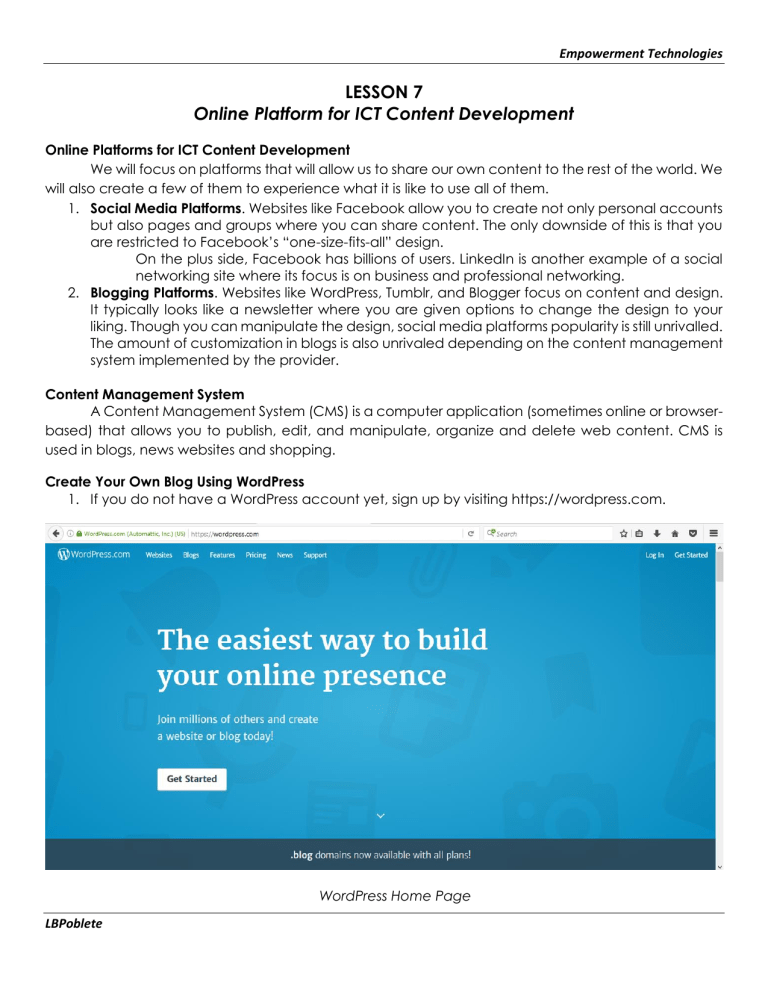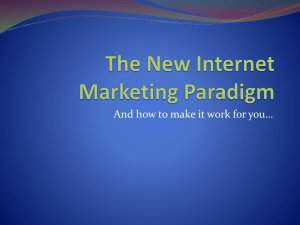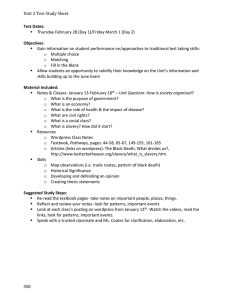
Empowerment Technologies LESSON 7 Online Platform for ICT Content Development Online Platforms for ICT Content Development We will focus on platforms that will allow us to share our own content to the rest of the world. We will also create a few of them to experience what it is like to use all of them. 1. Social Media Platforms. Websites like Facebook allow you to create not only personal accounts but also pages and groups where you can share content. The only downside of this is that you are restricted to Facebook’s “one-size-fits-all” design. On the plus side, Facebook has billions of users. LinkedIn is another example of a social networking site where its focus is on business and professional networking. 2. Blogging Platforms. Websites like WordPress, Tumblr, and Blogger focus on content and design. It typically looks like a newsletter where you are given options to change the design to your liking. Though you can manipulate the design, social media platforms popularity is still unrivalled. The amount of customization in blogs is also unrivaled depending on the content management system implemented by the provider. Content Management System A Content Management System (CMS) is a computer application (sometimes online or browserbased) that allows you to publish, edit, and manipulate, organize and delete web content. CMS is used in blogs, news websites and shopping. Create Your Own Blog Using WordPress 1. If you do not have a WordPress account yet, sign up by visiting https://wordpress.com. WordPress Home Page LBPoblete Empowerment Technologies 2. If it is your first time to visit the site, create your first blog. If you already have a blog, there is no need to delete it. WordPress allows you to create multiple blogs. Simply click Blog Posts under Publish in the dashboard. 3. Name your blog then click Publish. LBPoblete Empowerment Technologies 4. Click on Settings to change your site title, tagline and more information on you blog. You can set your site title and tagline. You may also change the other settings according to your preference. When done, click on Save Settings located at the top right of the page. 5. On the left menu, choose Themes. LBPoblete Empowerment Technologies 6. On the Themes page, select Free to filter out the paid themes. 7. Select any theme you want by hovering the mouse pointer over it then click Activate. Tip: if you are happy with the current theme, just hover over the theme then click Customize. LBPoblete Empowerment Technologies 8. Once this dialog box appears, click Customize. 9. You will be directed to a page where you can edit your website. WordPress Theme Customization Interface A B C a. Preview Window – shows you how the website would look like with the applied changes. b. Preview Selection – allows you to select what the preview window is showing. You can preview how your site would look like in a PC/Mac, a tablet, or a mobile phone (respectively). c. Customization Tools – allows you to customize the design (limited for free users), change the color and header, select a front page, add site widgets, and change the site title. 10. Customize the theme to your liking. Once done, click on Save on the bottom of the customization tools. Putting on Your WordPress Blog It is now time for us to add content to our WordPress blog. Follow these easy steps on how to post for the first time. 1. On your dashboard, go to Blog Posts, then click Add. LBPoblete Empowerment Technologies 2. Creating a post is pretty straightforward in WordPress. Just type a title, customize the URL (optional), and then post in the editor. 3. Compose a welcome message for your future readers with a minimum of 100 words. (Tip: A word counter is located at the bottom of the editor.) 4. You may also add a category so that your posts are organized. Add tags so that others can easily search your posts using the tags you specified. 5. Once done, you may preview your post. Once satisfied, click on Publish to post it on your website. Tip: You may also change the visibility options and schedule your post. See the screenshot below. LBPoblete Empowerment Technologies Cloud Computing Cloud computing is the practice of using a network of remote servers hosted on the Internet to store, manage, and process data, rather than a local server or a personal computer. Give yourself a minute to thing about the outputs that used “Cloud Computing.” When we used WordPress for making our own blog and creating our first post, we are in the process of cloud computing because we did not need to install any software in our computer. The software is in the “cloud” or over the Internet. Here are some advantages and disadvantages of cloud computing. Advantages 1. No need to install 2. Saves hard disk space 3. Easy access to your software/files; can be ran anywhere as long as there is Internet connection 4. Saves you money from buying software licenses and additional hard disk space 5. No need to update because it updates automatically 6. Minimum system requirements 7. Back up and data recovery are relatively easier than on a physical device Disadvantages 1. Can be hampered down by slow Internet speed; no connection, no cloud computing 2. May still require compatible software like a browser 3. You do not own the software; you are simply renting it 4. Security risk of doing things over the Internet as opposed to your personal computer alone 5. More prone to hacking 6. Limited control over the infrastructure itself Using cloud computing is generally up to you. Large companies opt to use the cloud because they do not need to pay licenses for each computer they have for their company; instead, they use a software on demand. Key Terms Content Management System (CMS) – a computer application that allows you to publish, edit, manipulate, organize, and delete web content. Blogging – focuses on content and design. It typically looks like a newsletter where you are given options to change the design to your liking. Social Media Platforms – allow you to create not only personal accounts but also pages and groups where you can share content. WordPress – a free blogging platform Theme – the overall design of a website LBPoblete


